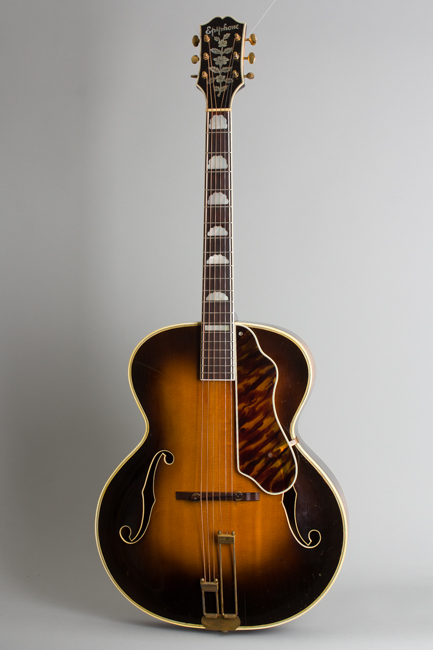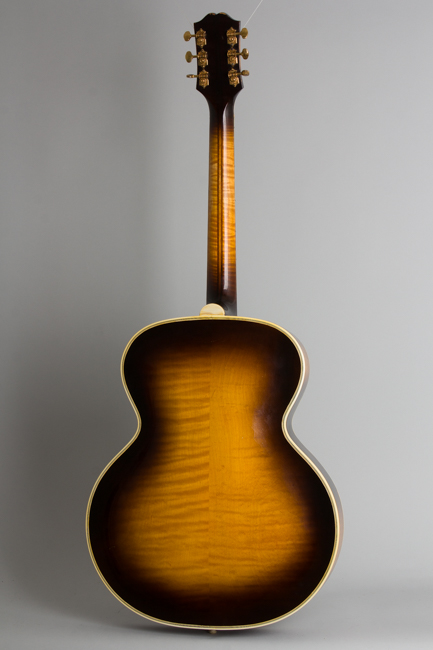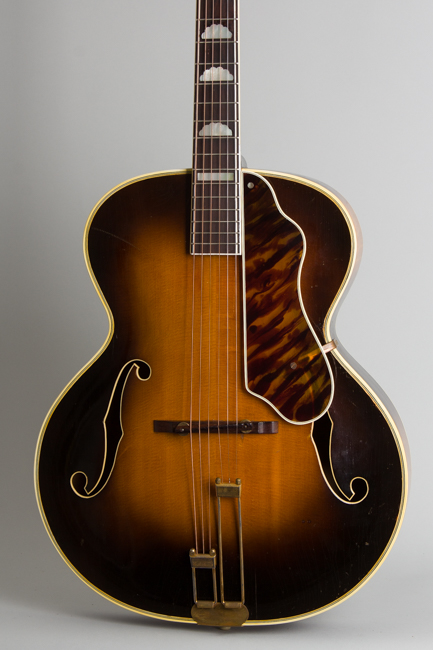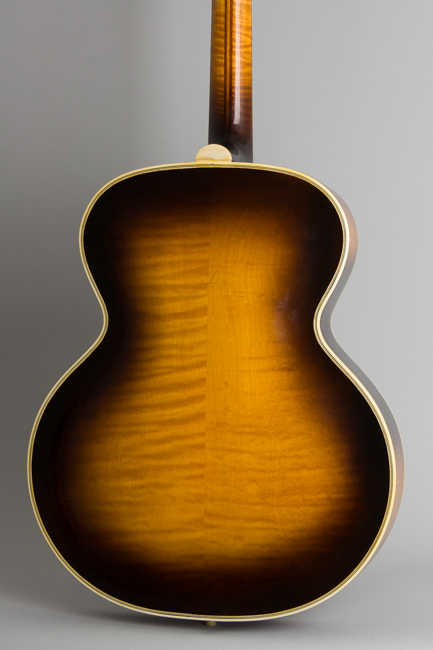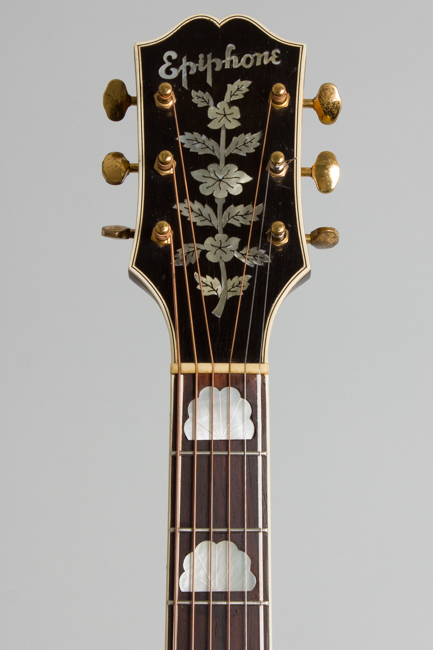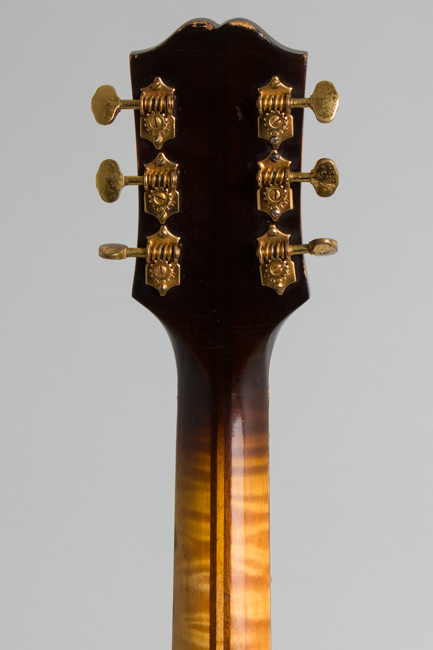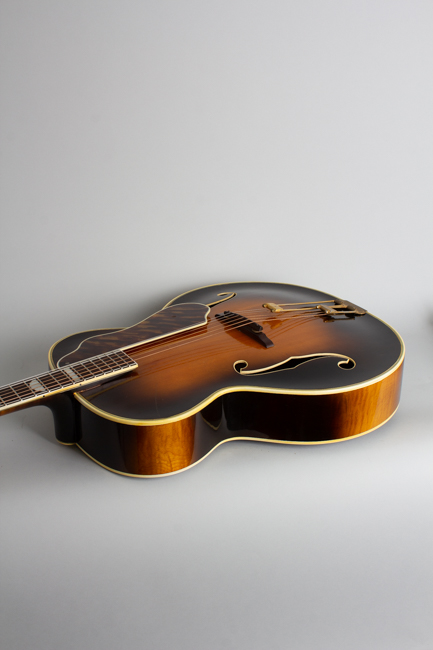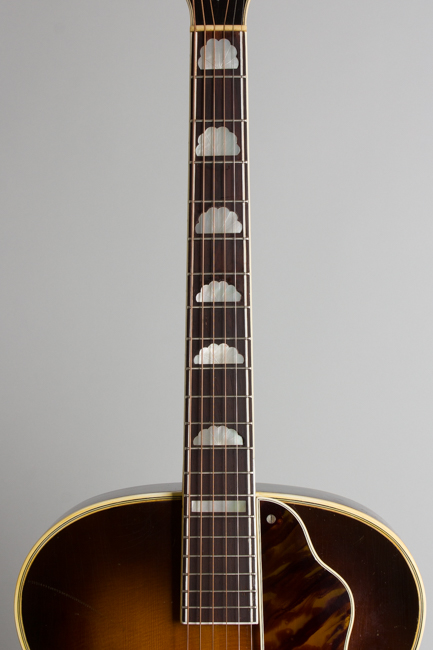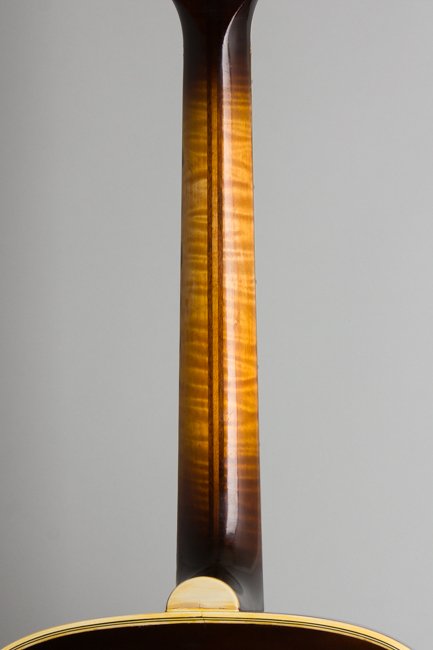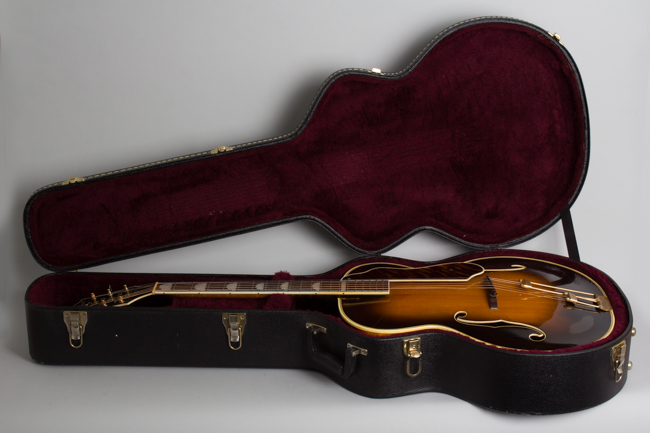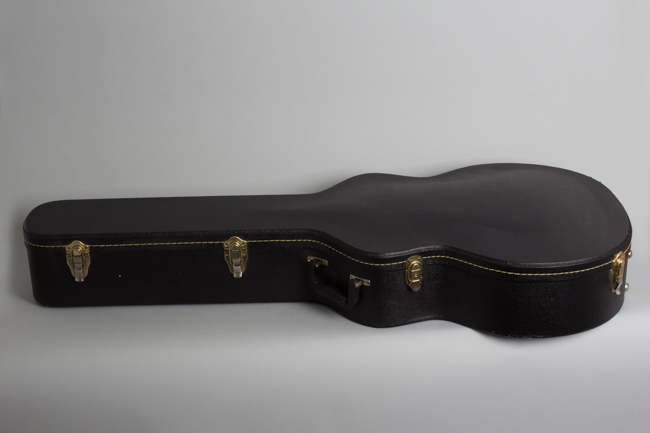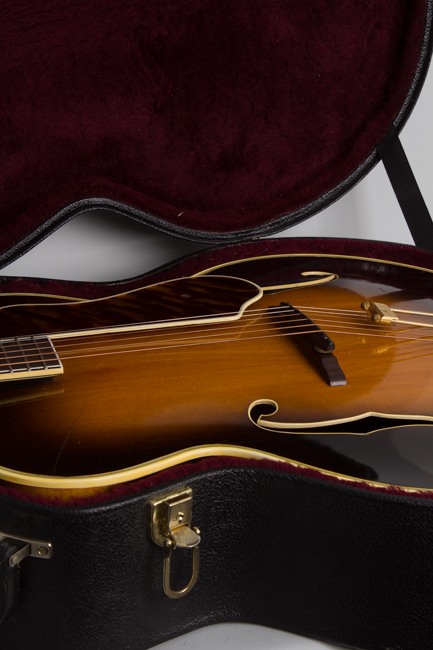Epiphone DeLuxe Arch Top Acoustic Guitar (1940)
This item has been sold.
Item # 11048
Prices subject to change without notice.
Epiphone DeLuxe Model Arch Top Acoustic Guitar (1940), made in New York City, serial # 14592, sunburst lacquer finish, Maple back and sides, spruce top; laminated maple neck with ebony fingerboard, black tolex hard shell case.
This guitar is an extremely well preserved, fine-playing and sounding original example of a "second generation" pre-war Epiphone DeLuxe, one of the classic orchestra guitars of all time. The Deluxe had been Epiphone's original top-line guitar from the beginning of the "Masterbilt" line 1931 until the Emperor was introduced in 1936. This enlarged 17 3/8" version of the DeLuxe was simultaneously developed as a response to arch-rival Gibson's "Advanced" arch-top line.
The DeLuxe and Emperor competed not only with the Gibson L-5 and Super 400 but individually built creations from John D'Angelico (about 20 minutes walk downtown), Willy Wilkanowski (a subway ride out to Greenpoint, Brooklyn), and Charles & Elmer Stromberg (a few hours north in Boston). Up into the war years Gibson's L-5 and the Deluxe were the top contenders for a 17" professional orchestra guitar, both used by many big band and small combo jazz greats. The relative merits of each are still debated today!
This DeLuxe dates to very early in 1940, likely from the first batch made that year. It has a mix of older and newer features specific to this year. At this time the Stathopoulo family maintained their guitar building operation on the second floor of a large loft building on West 14th street where Epiphone, Inc. operated an integrated factory and showroom in the heart of swing-era New York. The company was named for and headed up by Epaminondas ("Epi") Stathopoulo until his death in 1943. By all accounts he was an extremely fastidious and dedicated man, who personally inspected every instrument. All high-end carved-top Epiphone guitars are fine instruments, but those produced under Epi's watch are among the very best and were often preferred by the era's top players to anything else available.
This early 1940 Deluxe is an example of the more refined, "perfected" swing-era version, larger and sleeker than the original 1931-style "Masterbilt" model. The 17 3/8" wide body is bound in 5-ply celluloid on the front and back with single bound F-holes. The finish is a dark shaded sunburst lacquer showing off some subtle broad figure on the maple back. The tailpiece is Epiphone's patented "Frequensator" with separate tines for the bass and treble strings. The pickguard is an extended bound celluloid piece shared with the Emperor, secured by a simple gold-plated bracket.
The 5-piece laminated neck is slimmer than older models, with a profile halfway between a "C" and "V" and some fancy figure to the maple pieces. The bound rosewood fingerboard has the "segmented cloud" pearl inlay that would be simplified after the war. The bound headstock has the fancy "tree of life" pearl inlay on the face that was an Epiphone trademark. The peghead is fitted with individual openback Grover tuners, supplanted soon after this guitar was made by new heavy-duty Epiphone branded closed-back tuners.
These original high-end arch-top Epiphone guitars were quite popular among professional users when new, but well-preserved examples are surprisingly hard to find today. The sound is both rich and powerful, still retaining the definition older Epiphones are known for. We are always pleased to offer top-line New York Epiphones, especially pre-war ones. They are not only great guitars, but a huge part of our local NY musical heritage. Noted Jazz stylist John Pisano has employed a nearly identical DeLuxe for decades to great effect on a variety of projects.
Overall length is 42 in. (106.7 cm.), 17 3/8 in. (44.1 cm.) wide at lower bout, and 3 7/16 in. (8.7 cm.) in depth, measured at side of rim. Scale length is 25 1/2 in. (648 mm.). Width of nut is 1 11/16 in. (43 mm.).
This is a relatively clean, well-cared for original Epiphone with a spectacular sound. There is general wear to the original very thin lacquer including small dings, dents, and scrapes but no major areas of wear. The top has some scrapes under the bridge and random scuff narks off the treble end (possibly from a DeArmond control box) but less pick wear than many. The back and sides have only light wear marks. The finish on the back of the neck has a few spots down to the wood by the binding on the treble side but is fairly clean as well.
There are three sealed spruce cracks to the top, one just below the tailpiece and the others nearer the fingerboard. All are neatly closed with no notable overfinish. A small piece of binding under the heel is patched in, but the neck has never been reset. All hardware including the Grover tuners, Frequensator tailpiece, rosewood bridge and even the celluloid pickguard are original. The tailpiece has lost much of its plating but seems to have escaped needing the common repair at the bend. Even the pickguard is original, not having suffered the celluloid decay that plagues many of them.
The neck has been neatly refretted in the original style wire; great care was taken to preserve the delicate engraving in the original cloud inlay. Playability is excellent and this is one of the best sounding swing era guitars we have had in a some time, incisive but never thin sounding and more responsive than many large archtops. This prewar DeLuxe is a real treat to play and see for the vintage archtop fan, and a great sounding guitar for many styles of play. It is housed in a well-fitted modern HSC. Overall Excellent Condition.
This guitar is an extremely well preserved, fine-playing and sounding original example of a "second generation" pre-war Epiphone DeLuxe, one of the classic orchestra guitars of all time. The Deluxe had been Epiphone's original top-line guitar from the beginning of the "Masterbilt" line 1931 until the Emperor was introduced in 1936. This enlarged 17 3/8" version of the DeLuxe was simultaneously developed as a response to arch-rival Gibson's "Advanced" arch-top line.
The DeLuxe and Emperor competed not only with the Gibson L-5 and Super 400 but individually built creations from John D'Angelico (about 20 minutes walk downtown), Willy Wilkanowski (a subway ride out to Greenpoint, Brooklyn), and Charles & Elmer Stromberg (a few hours north in Boston). Up into the war years Gibson's L-5 and the Deluxe were the top contenders for a 17" professional orchestra guitar, both used by many big band and small combo jazz greats. The relative merits of each are still debated today!
This DeLuxe dates to very early in 1940, likely from the first batch made that year. It has a mix of older and newer features specific to this year. At this time the Stathopoulo family maintained their guitar building operation on the second floor of a large loft building on West 14th street where Epiphone, Inc. operated an integrated factory and showroom in the heart of swing-era New York. The company was named for and headed up by Epaminondas ("Epi") Stathopoulo until his death in 1943. By all accounts he was an extremely fastidious and dedicated man, who personally inspected every instrument. All high-end carved-top Epiphone guitars are fine instruments, but those produced under Epi's watch are among the very best and were often preferred by the era's top players to anything else available.
This early 1940 Deluxe is an example of the more refined, "perfected" swing-era version, larger and sleeker than the original 1931-style "Masterbilt" model. The 17 3/8" wide body is bound in 5-ply celluloid on the front and back with single bound F-holes. The finish is a dark shaded sunburst lacquer showing off some subtle broad figure on the maple back. The tailpiece is Epiphone's patented "Frequensator" with separate tines for the bass and treble strings. The pickguard is an extended bound celluloid piece shared with the Emperor, secured by a simple gold-plated bracket.
The 5-piece laminated neck is slimmer than older models, with a profile halfway between a "C" and "V" and some fancy figure to the maple pieces. The bound rosewood fingerboard has the "segmented cloud" pearl inlay that would be simplified after the war. The bound headstock has the fancy "tree of life" pearl inlay on the face that was an Epiphone trademark. The peghead is fitted with individual openback Grover tuners, supplanted soon after this guitar was made by new heavy-duty Epiphone branded closed-back tuners.
These original high-end arch-top Epiphone guitars were quite popular among professional users when new, but well-preserved examples are surprisingly hard to find today. The sound is both rich and powerful, still retaining the definition older Epiphones are known for. We are always pleased to offer top-line New York Epiphones, especially pre-war ones. They are not only great guitars, but a huge part of our local NY musical heritage. Noted Jazz stylist John Pisano has employed a nearly identical DeLuxe for decades to great effect on a variety of projects.
Overall length is 42 in. (106.7 cm.), 17 3/8 in. (44.1 cm.) wide at lower bout, and 3 7/16 in. (8.7 cm.) in depth, measured at side of rim. Scale length is 25 1/2 in. (648 mm.). Width of nut is 1 11/16 in. (43 mm.).
This is a relatively clean, well-cared for original Epiphone with a spectacular sound. There is general wear to the original very thin lacquer including small dings, dents, and scrapes but no major areas of wear. The top has some scrapes under the bridge and random scuff narks off the treble end (possibly from a DeArmond control box) but less pick wear than many. The back and sides have only light wear marks. The finish on the back of the neck has a few spots down to the wood by the binding on the treble side but is fairly clean as well.
There are three sealed spruce cracks to the top, one just below the tailpiece and the others nearer the fingerboard. All are neatly closed with no notable overfinish. A small piece of binding under the heel is patched in, but the neck has never been reset. All hardware including the Grover tuners, Frequensator tailpiece, rosewood bridge and even the celluloid pickguard are original. The tailpiece has lost much of its plating but seems to have escaped needing the common repair at the bend. Even the pickguard is original, not having suffered the celluloid decay that plagues many of them.
The neck has been neatly refretted in the original style wire; great care was taken to preserve the delicate engraving in the original cloud inlay. Playability is excellent and this is one of the best sounding swing era guitars we have had in a some time, incisive but never thin sounding and more responsive than many large archtops. This prewar DeLuxe is a real treat to play and see for the vintage archtop fan, and a great sounding guitar for many styles of play. It is housed in a well-fitted modern HSC. Overall Excellent Condition.
